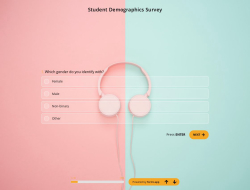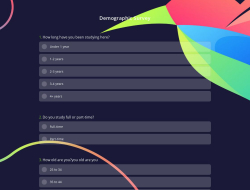Before starting avoiding assumptions and being sensitive is a key motif in this article. It is understandable to have hesitations regarding ethnicity questions in surveys, but there is a difference between race and ethnicity. And ethnicity surveys are essential for social science research and business research.
Since ethnicity questions are necessary for different areas such as market research, business research, academic research, health care, education, etc., this article will aim to help you create sensitive ethnicity questionnaires with forms.app and look for important tips before creating your survey.
What is an ethnicity survey question?
An ethnicity survey question is a question that aims to identify the responders' ethnicity or cultural background. A shared identity and culture based on genealogy, language, history, and beliefs are referred to as ethnicity, which is a social and cultural notion.
It is frequently used to classify and research social groupings according to their national and cultural heritages. When asked about their ethnicity in a survey, participants may choose from a list of possibilities or write down their answers. Research frequently uses ethnicity survey questions to examine the link between ethnicity and other important characteristics and the demographics of a sample.
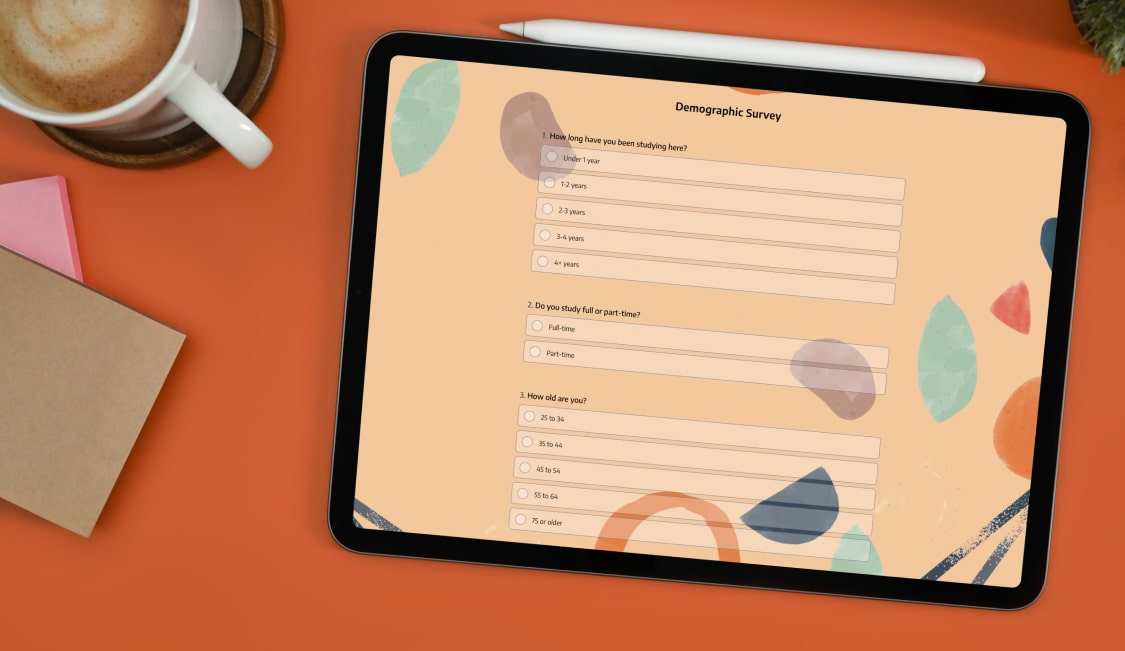
Is it okay to ask ethnicity questions?
As long as the questions are appropriate to the research objectives and are presented ethically and respectfully, it is typically okay to speak about ethnicity in surveys and research studies. Ethnicity is a significant component of one's identity and may play a significant role in understanding the viewpoints and experiences of both people and communities. A population's variety can be better understood by asking questions on ethnicity, which can also aid researchers in spotting ethnic trends and patterns.
However, it's also crucial to consider any moral dilemmas that might arise from questioning someone about their ethnicity. Information gathered may be misused in a negative or discriminatory way. For this reason, researchers should ensure their survey questions are well-written, considerate, and sensitive to the requirements of the respondents in order to reduce these vulnerabilities. Additionally, they must verify that the data is handled and stored securely and have a clear strategy for its use.
In which survey types do you need race and ethnicity information?
To prevent inequalities, medical research, and economic research, ethnicity surveys are very useful for learning about the target audience in a sensitive way. So if you need to find a way to learn the pattern of how ethnicity affects someone's decision in any particular field, you can use ethnicity surveys. Here are some example fields where it is useful:
- Demographic surveys: These surveys are frequently used to gather data on a population's characteristics, including data on race and ethnicity.
- Health surveys: Understanding and resolving health inequalities might involve consideration of race and ethnicity. As a result, inquiries about race and ethnicity are common in health surveys.
- Social and economic surveys: Surveys on social and economic trends and patterns may also ask about race and ethnicity in order to better understand these trends and patterns.
- Educational surveys: To better identify and rectify any inequalities that may exist within the educational system, school surveys may also contain questions on race and ethnicity.
Let’s get something straight first: ethnicity vs. race
Race and ethnicity are two different ideas, but they are linked together, which makes them complicated. Typically, race is viewed as a social construct that divides people into groups based on physical traits like skin tone, eye color, and facial features. At the same time, ethnicity describes a common cultural legacy, including language, religion, and country of origin.
In studies on various issues and understanding and correcting social and economic inequality, race and ethnicity may be significant determinants. When gathering and reporting data on race and ethnicity, it is crucial to understand the differences between these two ideas and to use the proper terminology. So if you have an idea about the difference between ethnicity and race, you must wonder what culture is.
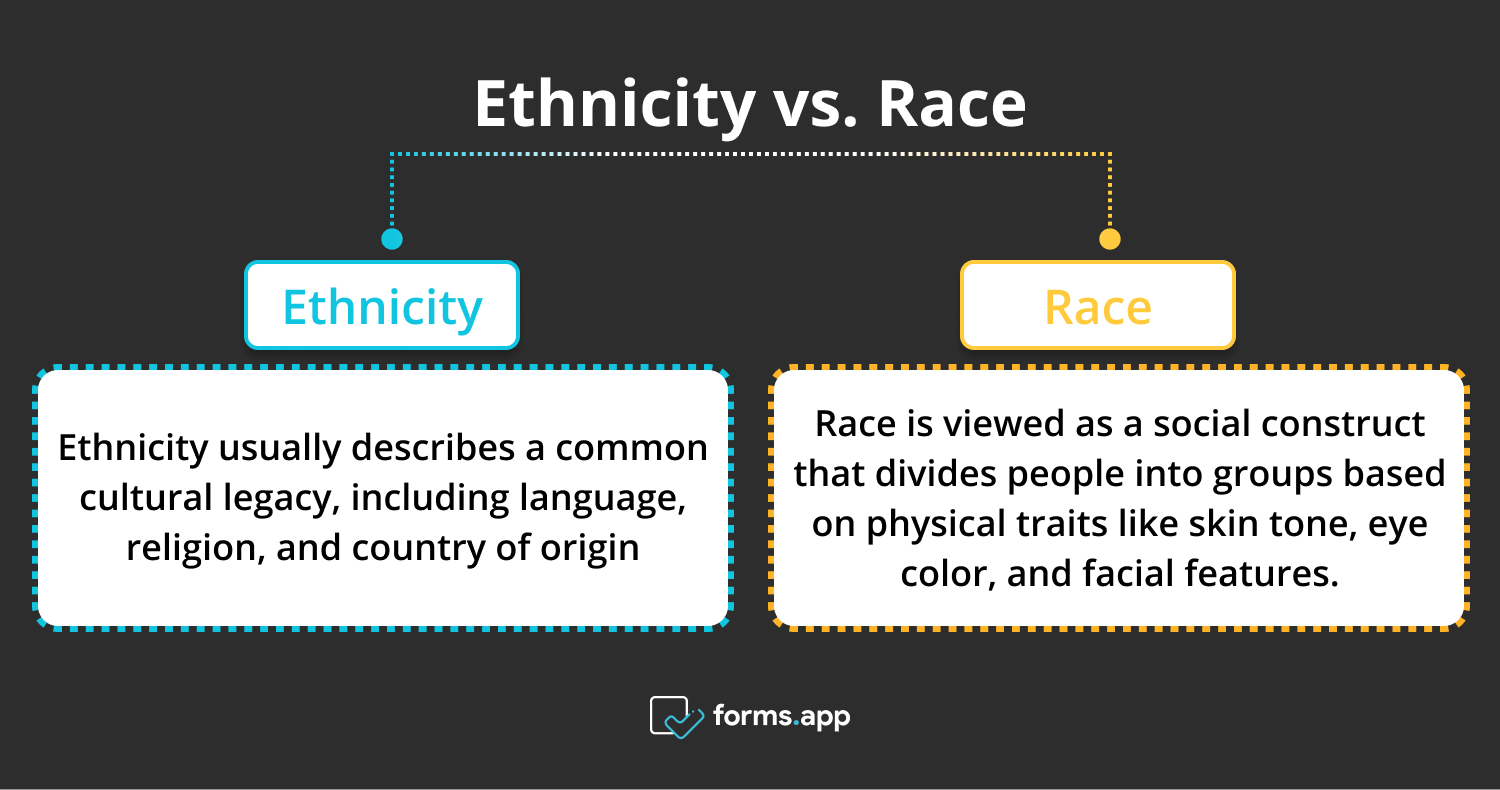
An alternative to ethnicity and race questions: culture
A community or civilization is defined by its common ideas, practices, artifacts, and other traits, which are referred to as its culture. Cultural examples are language, traditions, conventions, the arts, and other forms of expression. Numerous elements, such as history, religion, and social and economic circumstances, can influence culture.
An individual's identity and sense of belonging may be greatly influenced by culture. Additionally, it might affect a person's interactions with other people and their beliefs, attitudes, and behaviors. It can be beneficial to comprehend and appreciate cultural differences in various contexts, such as the workplace, healthcare, and education.You can simply ask “Do you consider yourself to be part of a specific cultural community?“
Ethnicity question examples to use in your next survey
Depending on your preference, you may choose different approaches to race and ethnicity survey questions. You can ask directly with open-ended answers, you may find it more suitable to ask it with multiple choice, or you may choose to ask low-pressure (indirect) questions to make it more sensitive and unbiased to the responder. Here are different question types of survey questions examples:
Direct questions: These types of questions aim to get the answer without any concern or hesitation. You may use these questions if you can clarify your purpose clearly without offending them.
- What is your race?
- What is your primary racial or ethnic group?
- What is your ethnic background?
- What is your ancestry or national origin?
- What is your country of birth?
- What is your ancestry or family heritage?
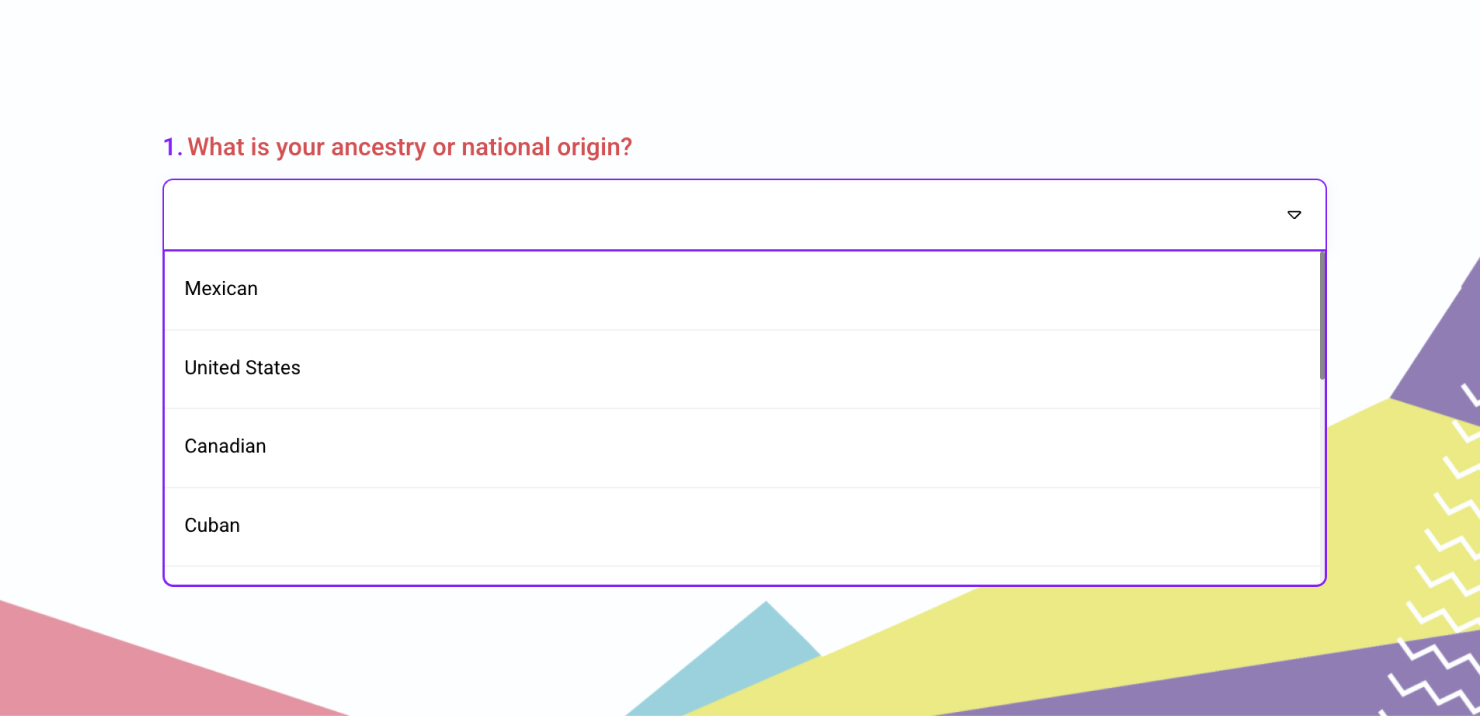
Low-pressure questions: If you don't want to offend the responder and cant clarify your purpose directly, you may choose these indirect questions with open-ended answer options for your responders to fill in.
- How do you identify your racial or ethnic background? (provide a list of options or a fill-in-the-blank response)
- Do you consider yourself to be part of a specific cultural or ethnic group? If so, which group(s)?
- What is your primary language spoken at home?
- Do you consider yourself to be part of a specific ethnic or cultural community? If so, which community?
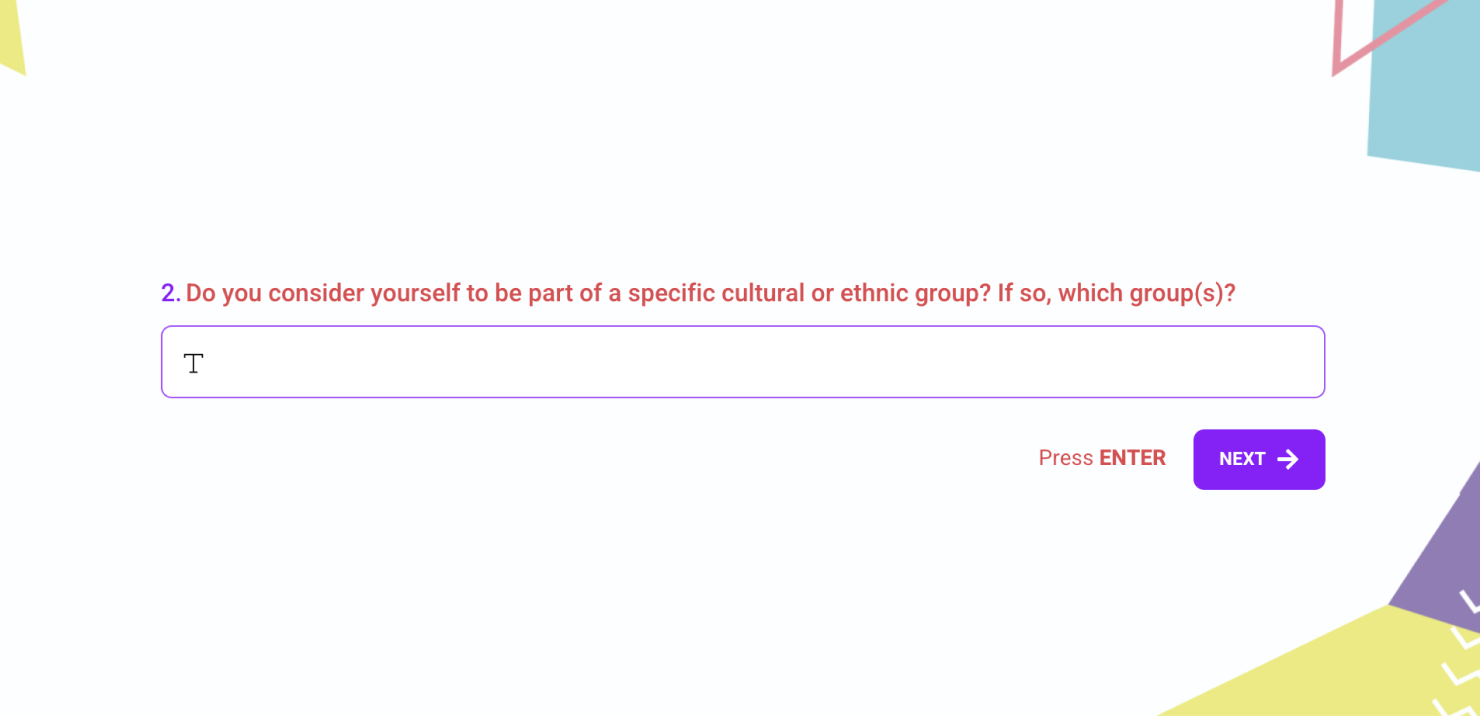
Multiple selection questions: You can offer them the answers listed but be careful this may also be misunderstood, so be sure you clarify your reasons for gathering data.
- Do you consider yourself to be of Hispanic, Latino, or Spanish origin?
- Which of the following best describes your ethnic identity? (provide a list of options, such as "Hispanic or Latino," "African American," "White," "Asian," "Native American," etc.)
- Which of the following categories best describes your racial or ethnic identity? (provide a list of options)
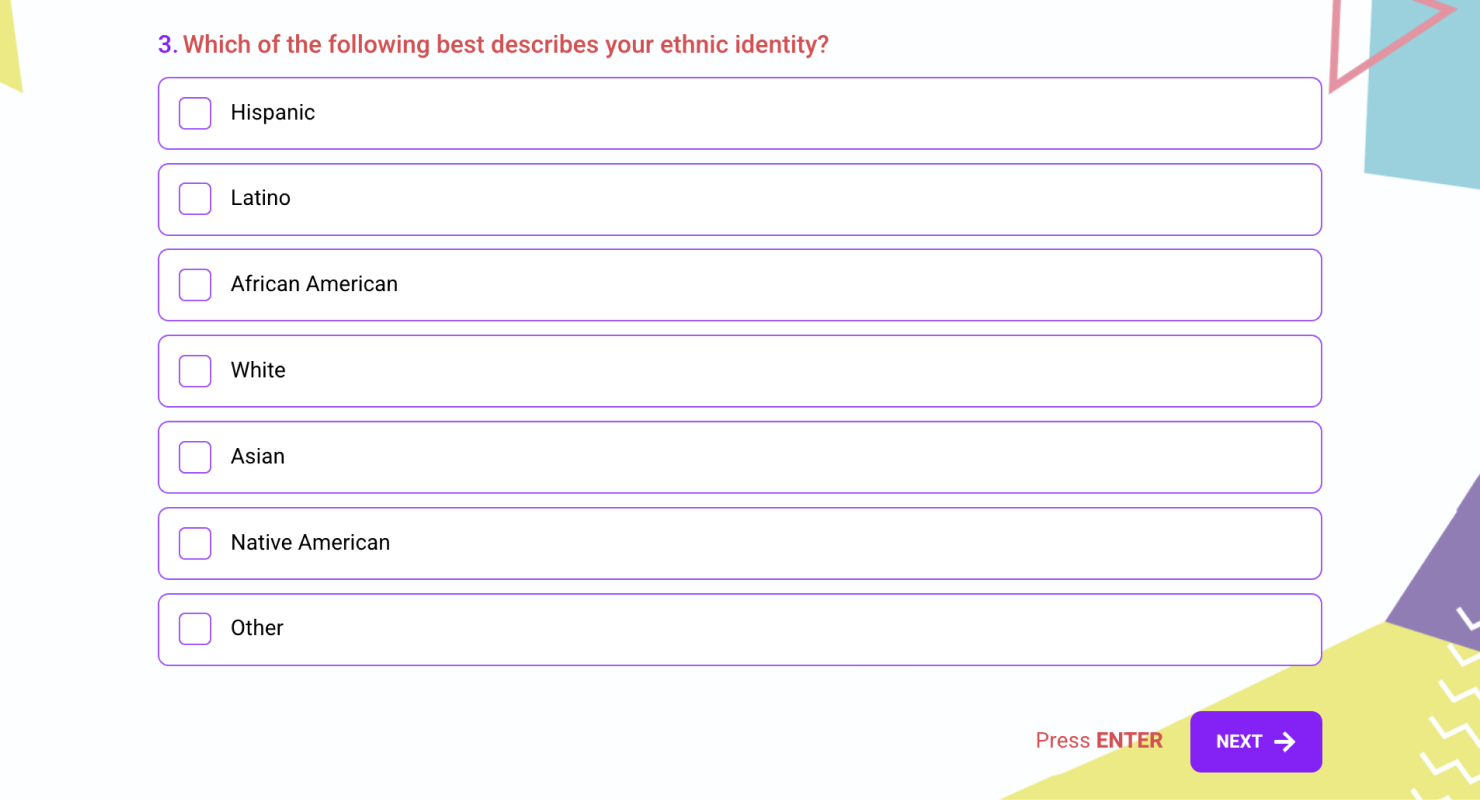
How to ask for ethnicity without offending anyone
The most important part of your survey is not the way you ask questions. You have to give your responders a reason to answer your questions. To do that, you have to ensure them about the security of the data and the aim of the survey, and whatever you ask, you have to be understanding toward your responders in any condition. Here are the key aspects of ethnicity questions:
1 - Verify the relevance of these questions to your objectives: Let respondents know why you are asking about their ethnicity and how the information will be used. This can help put them at ease and make them more comfortable answering the question.
2 - Give respondents a chance to decline: Give them the option to decline to answer the question if they feel uncomfortable doing so. You can add an “I don’t want to answer” option, and you can make the question “optional” if it is not necessary for your research.
3 - Allow responders to choose a different choice from the ones listed: Ethnicity may not always align with the options provided: It's important to recognize that not all ethnicities can be captured by a fixed set of options. Consider offering an "other" option and allowing respondents to write in their ethnicity.
4 - Use inclusive language: Avoid using language that excludes or marginalizes certain groups. For example, instead of asking, "What is your race?" you could ask, "What is your ethnic background or ancestry?"
5 - Add as many answer choices as possible: If you are not targeting a special area, you can add multiple answers to your online survey to make it a good survey question, such as; European, American Indian, Alaska Native, Mexican, Canadian, Chinese, Asian , Hawaiian, or Pacific Islander
Summary
In conclusion, if you are reading this article, you know the importance of the delicacy in these questions, and being sensitive and understanding toward your responders is the essence of ethnicity questions. You should be careful with your choice of form builder when it comes to such sensitive subjects as ethnicity and, we believe forms.app must be your choice with its free customizable ready-made templates.

